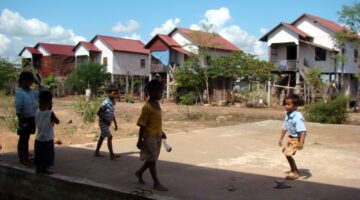
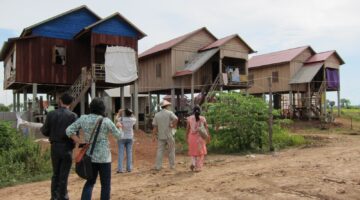
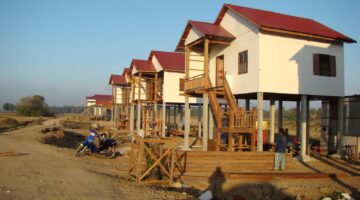

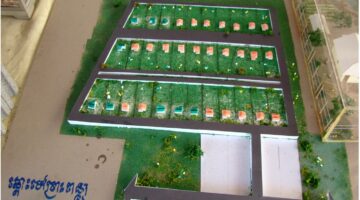
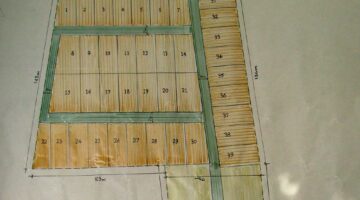
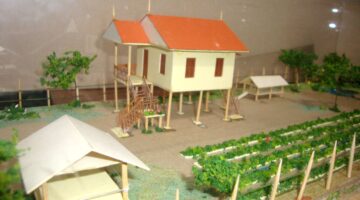
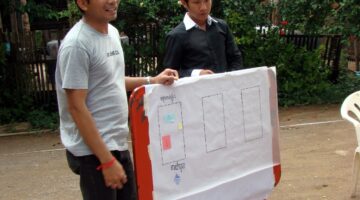

Poun Lue Reatrey Senchey - The resettlement of the Monorom community
Main objectives of the project
Serey Sophoan's journey towards inclusive urban development is a testament to the power of community-driven initiatives and government collaboration. Initially plagued by slum settlements and eviction threats, the city's poor communities found hope through collective action and partnership-building. With support from organizations like the Asian Coalition for Housing Rights (ACHR) and the Urban Poor Development Fund (UPDF), residents embarked on a journey of self-reliance, leveraging the "Social Land Concessions" regulation to secure land for resettlement projects. For the Monorom community, facing perennial floods and housing insecurity, this initiative offered a lifeline. By actively participating in the design and construction of their new homes, residents not only gained secure housing but also a renewed sense of dignity and empowerment. Today, Serey Sophoan stands as a beacon of inclusive urban development, where community-led solutions pave the way for change.
Date
- 2010: Construction
Stakeholders
- Promotor: Poun Lue Reatrey Senchey community members
- The Municipality of Serey Sophoan
- The Banteay Meanchey Provincial Government
- Asian Coalition for Housing Rights (ACHR)
- Community Savings Network of Cambodia (CSNC)
- Urban Poor Development Fund (UPDF)
Location
Description
Serey Sophoan, known as Sisophon in its historical context, stands as a microcosm of Cambodia's secondary cities grappling with urbanization's complexities. A 2009 survey revealed that 17% of its population, roughly 7,300 people, inhabited 19 slum settlements, situated precariously along rivers, roadsides, and railway lines. These communities faced isolation, insecurity, and the looming threat of eviction. However, collaborative efforts spearheaded by the Asian Coalition for Housing Rights (ACHR), Serey Sophoan District Authority, the national Community Savings Network of Cambodia (CSNC), and the Urban Poor Development Fund (UPDF) initiated a transformative journey. Through collective savings (supported by the UPDF) in 2005, local women formed groups, managing common loan funds to address emergencies, household needs, and livelihood challenges. The establishment of savings groups laid the groundwork for community organizing and small-scale upgrading projects, buoyed by partnerships forged with various levels of government, particularly with the Municipal Governor, fostering a newfound sense of empowerment and possibility among the urban poor.
After a survey, the inception of the Asian Coalition for Community Action (ACCA), a ACHR program, in 2009 marked a pivotal moment for vulnerable communities facing imminent eviction threats. One of them was Monorom - a settlement of 30 households that was also built along the river, right across from Poun Lea Meanchey. The ACCA program played a pivotal role in empowering vulnerable communities across Asia to mobilize, establish networks, and pool resources through collective savings, enabling them to engage in negotiations with municipal governments to tackle poverty and housing challenges on a citywide scale. Additionally, the program was underpinned by the 2001 regulation of "Social Land Concessions," a mechanism aimed at securing land for landless individuals or groups. This regulation granted beneficiaries the right to farm and build houses on state-owned land, essentially affording them ownership rights for the concession period. Notably, the provision of land to communities free of charge, along with a collective land certificate, represented a groundbreaking initiative by the Banteay Meanchey provincial government to promote communal ownership and utilization of land, departing from the conventional model of individual ownership.
Leveraging the 2001 regulation of "Social Land Concessions" and the support of the ACCA, the Monorom community embarked on a groundbreaking resettlement project. Covering an area of 30,000 square meters (7.4 acres), the new land provided a canvas for transformation with assistance from UPDF. A team of youthful and visionary community architects collaborated with the Monorom community to orchestrate a participatory process for designing the layout of their future settlement and conceptualizing their residences. After extensive deliberations and refinements, a layout plan was devised, allocating 30% of the land (16,500 square meters) for infrastructure, including roads and public spaces, and dedicating 60% (13,500 square meters) for 30 spacious residential plots. These plots, spanning 455 square meters each (13 m x 35 m), were envisioned as "self-sufficiency" areas, intended not only for housing but also for fostering food production and livelihood activities. Featuring ample space for vegetable gardens, fruit trees, fish-rearing ponds, and livestock enclosures, these plots aimed to promote self-reliance and sustainability. Subsequently, the community members, in collaboration with architects, embarked on designing the houses. Despite the land being raised above normal flood levels, the decision was made to elevate the houses on tall pre-cast concrete columns, considering Cambodia's susceptibility to floods. Each dwelling, encompassing approximately 30 square meters, comprised wooden structural elements and walls finished with timber boards or fiber cement boards. Reflecting Khmer tradition, the houses were designed to harvest rainwater during the monsoon season, channeling it into large pots for consumption and sanitation purposes during the dry season. The construction was swiftly executed, culminating in residents moving in by the end of 2010.
For years, the Monorom community faced the daunting challenge of potential eviction and devastating annual floods that frequently destroyed their homes. However, their relocation to more secure and spacious land marked a significant turning point in their lives. This resettlement endeavor underscored that providing adequate housing for impoverished communities does not necessarily demand extensive resources. Instead, when communities are actively engaged in the process and receive support from local authorities and other stakeholders, significant progress can be achieved. Since the completion of the project, Monorom residents have thrived in a secure and well-structured community, fostering strong social connections and advancing their livelihoods. Furthermore, the project has emerged as a benchmark for addressing food security and implementing resettlement initiatives. The strategies employed, including collective savings, collaboration with local government, and the introduction of "social land concessions," have set a precedent for the province to emulate.

